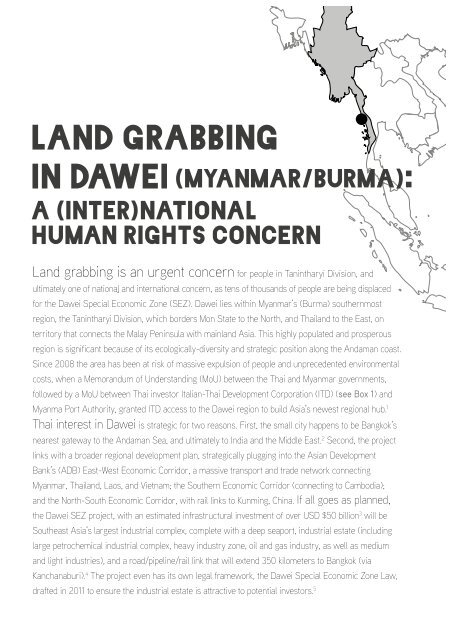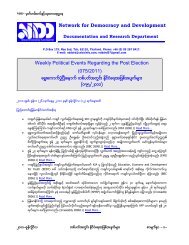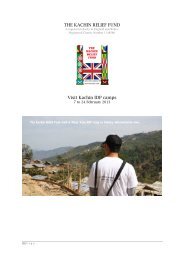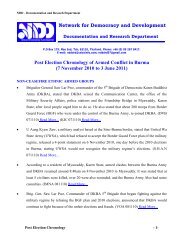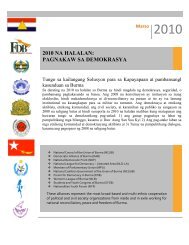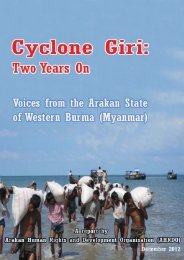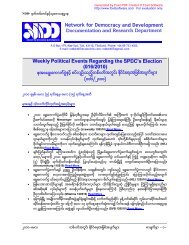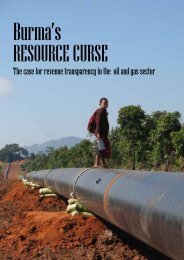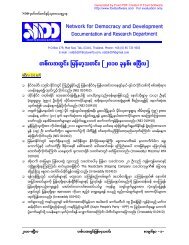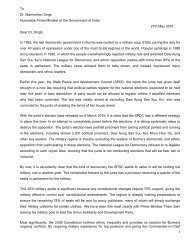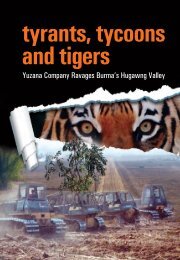Land Grabbing in Dawei (MyanmarI Burma): - Transnational Institute
Land Grabbing in Dawei (MyanmarI Burma): - Transnational Institute
Land Grabbing in Dawei (MyanmarI Burma): - Transnational Institute
- No tags were found...
Create successful ePaper yourself
Turn your PDF publications into a flip-book with our unique Google optimized e-Paper software.
<strong>Land</strong> <strong>Grabb<strong>in</strong>g</strong><strong>in</strong> <strong>Dawei</strong> (<strong>MyanmarI</strong> <strong>Burma</strong>):a (Inter)NationalHuman Rights Concern<strong>Land</strong> grabb<strong>in</strong>g is an urgent concern for people <strong>in</strong> Tan<strong>in</strong>tharyi Division, andultimately one of national and <strong>in</strong>ternational concern, as tens of thousands of people are be<strong>in</strong>g displacedfor the <strong>Dawei</strong> Special Economic Zone (SEZ). <strong>Dawei</strong> lies with<strong>in</strong> Myanmar’s (<strong>Burma</strong>) southernmostregion, the Tan<strong>in</strong>tharyi Division, which borders Mon State to the North, and Thailand to the East, onterritory that connects the Malay Pen<strong>in</strong>sula with ma<strong>in</strong>land Asia. This highly populated and prosperousregion is significant because of its ecologically-diversity and strategic position along the Andaman coast.S<strong>in</strong>ce 2008 the area has been at risk of massive expulsion of people and unprecedented environmentalcosts, when a Memorandum of Understand<strong>in</strong>g (MoU) between the Thai and Myanmar governments,followed by a MoU between Thai <strong>in</strong>vestor Italian-Thai Development Corporation (ITD) (see Box 1) andMyanma Port Authority, granted ITD access to the <strong>Dawei</strong> region to build Asia’s newest regional hub. 1Thai <strong>in</strong>terest <strong>in</strong> <strong>Dawei</strong> is strategic for two reasons. First, the small city happens to be Bangkok’snearest gateway to the Andaman Sea, and ultimately to India and the Middle East. 2 Second, the projectl<strong>in</strong>ks with a broader regional development plan, strategically plugg<strong>in</strong>g <strong>in</strong>to the Asian DevelopmentBank’s (ADB) East-West Economic Corridor, a massive transport and trade network connect<strong>in</strong>gMyanmar, Thailand, Laos, and Vietnam; the Southern Economic Corridor (connect<strong>in</strong>g to Cambodia);and the North-South Economic Corridor, with rail l<strong>in</strong>ks to Kunm<strong>in</strong>g, Ch<strong>in</strong>a. If all goes as planned,the <strong>Dawei</strong> SEZ project, with an estimated <strong>in</strong>frastructural <strong>in</strong>vestment of over USD $50 billion 3 will beSoutheast Asia’s largest <strong>in</strong>dustrial complex, complete with a deep seaport, <strong>in</strong>dustrial estate (<strong>in</strong>clud<strong>in</strong>glarge petrochemical <strong>in</strong>dustrial complex, heavy <strong>in</strong>dustry zone, oil and gas <strong>in</strong>dustry, as well as mediumand light <strong>in</strong>dustries), and a road/pipel<strong>in</strong>e/rail l<strong>in</strong>k that will extend 350 kilometers to Bangkok (viaKanchanaburi). 4 The project even has its own legal framework, the <strong>Dawei</strong> Special Economic Zone Law,drafted <strong>in</strong> 2011 to ensure the <strong>in</strong>dustrial estate is attractive to potential <strong>in</strong>vestors. 5
<strong>Land</strong> <strong>Grabb<strong>in</strong>g</strong> <strong>in</strong> <strong>Dawei</strong> (<strong>MyanmarI</strong><strong>Burma</strong>): a (Inter)National Human Rights ConcernBox 1. About Italian-Thai Development Corporation (ITD)The Italian-Thai Development Public Company Limited (ITD) was established <strong>in</strong> 1954 by Thai bus<strong>in</strong>essmanDr. Chaijudh Karnasuta and Italian bus<strong>in</strong>essman Mr. Giorgio Berl<strong>in</strong>gieri. Based <strong>in</strong> Bangkok, andlisted on the Stock Exchange of Thailand s<strong>in</strong>ce 1994, ITD is Thailand’s largest <strong>in</strong>frastructure constructioncompany and one of the country’s largest corporations. 1 In 2011 the Company’s reported revenuewas over Baht 44,000 million (USD $1.4 billion), a 22.6 per cent <strong>in</strong>crease from 2010.2 The companyexpects, by the end of 2012, to have over Baht 200 billion (USD $6.4 billion) worth of <strong>in</strong>vestments. 3Accord<strong>in</strong>g to the <strong>Dawei</strong> Development Company website (2012), ITD has completed more than 1,500projects both <strong>in</strong> Thailand and <strong>in</strong>ternationally <strong>in</strong> Bangladesh, Cambodia, India, Indonesia, Laos, Maldives,Madagascar, Myanmar, Philipp<strong>in</strong>es and Taiwan. Construction projects <strong>in</strong>clude: build<strong>in</strong>gs; <strong>in</strong>dustrialplants; pipel<strong>in</strong>es and utility works; highways, railways, bridges and expressways; airports, ports andmar<strong>in</strong>e works; dams, tunnels and power plants; m<strong>in</strong><strong>in</strong>g; steel structures; and telecommunications.In regards to the <strong>Dawei</strong> Industrial Estate and SEZ, the company <strong>in</strong>itially committed a 75 per cent <strong>in</strong>vestment,with possible renewal. However, there has been speculation that the company will announceits withdrawal of 50 per cent of the total project <strong>in</strong>vestment due to f<strong>in</strong>ancial constra<strong>in</strong>ts. 5 In any case,ITD will rema<strong>in</strong> the primary stakeholder <strong>in</strong> the project, as it seeks Japanese and other potential <strong>in</strong>vestorsto step <strong>in</strong> to assist <strong>in</strong> the projects development. This does not change the scope of the exist<strong>in</strong>gproject though, it rema<strong>in</strong>s that ITD was granted access by the Myanmar Government a total of 250square kilometers for which they will pay USD $37.5 million for 60 years (accord<strong>in</strong>g the company’s annualreport, the stated 204.9 square kilometers will be developed, however the rema<strong>in</strong><strong>in</strong>g 44.9 squarekilometers have not been accounted for). 6<strong>Dawei</strong> is not ITD’s only <strong>in</strong>terest <strong>in</strong> Myanmar; <strong>in</strong> 2007 ITD, under the name Myanmar ITD Co. Ltd.,gave a USD $3.79 million loan to the Defense M<strong>in</strong>istry of the Union of Myanmar for the constructionof a steel mill. 7 In Tan<strong>in</strong>tharyi division, near Myeik (south of <strong>Dawei</strong>), ITD together with W<strong>in</strong>dfallEnergy Services Ltd. (S<strong>in</strong>gapore) signed an MoU <strong>in</strong> 2008 to construct a hydroelectric project on theTenasserim River. 8 Nearby, <strong>in</strong> Shan State, the company has signed a tariff MoU with the ElectricityGenerat<strong>in</strong>g Authority of Thailand, <strong>in</strong> relation to a coal m<strong>in</strong><strong>in</strong>g project <strong>in</strong> Mhai Kok for the exportation ofcoal and electricity (369 megawatts) to Thailand, 9 and has conducted a feasibility study <strong>in</strong> Nam Kok fora hydropower dam. 101. Italian Thai Development (2011) Annual Report 2011: The Lead<strong>in</strong>gContractor <strong>in</strong> South East Asia. Bangkok, Thailand.2. ibid.3. ibid.4. Italian Thai Development (2010) Annual Report 2010. Bangkok,Thailand.5. Anonymous (A2), <strong>Dawei</strong> Community Activist, PersonalCommunication [email], 14.09.2012.6. Italian Thai Development (2011) Annual Report 2011: The Lead<strong>in</strong>gContractor <strong>in</strong> South East Asia. Bangkok, Thailand.7. Thakh<strong>in</strong>, T. (2012) “<strong>Dawei</strong> Development Project is Creat<strong>in</strong>g theNegative Impacts of <strong>Land</strong> Confiscation, Chang<strong>in</strong>g Lifestyles, andLack of Livelihoods for Local People East and West of <strong>Dawei</strong>”<strong>in</strong> Where the Change has Yet to Reach: Expos<strong>in</strong>g Ongo<strong>in</strong>g EarthRights Abuses <strong>in</strong> Myanmar. Thailand: EarthRights International.8. Italian Thai Development (2011) Annual Report 2011: The Lead<strong>in</strong>gContractor <strong>in</strong> South East Asia. Bangkok, Thailand.9. Thakh<strong>in</strong>, T. (2012) “<strong>Dawei</strong> Development Project is Creat<strong>in</strong>g theNegative Impacts of <strong>Land</strong> Confiscation, Chang<strong>in</strong>g Lifestyles, andLack of Livelihoods for Local People East and West of <strong>Dawei</strong>”<strong>in</strong> Where the Change has Yet to Reach: Expos<strong>in</strong>g Ongo<strong>in</strong>g EarthRights Abuses <strong>in</strong> Myanmar. Thailand: EarthRights International.10. Anonymous (A2), <strong>Dawei</strong> Community Activist, PersonalInterview, <strong>Dawei</strong>, 14.08.12.2
<strong>Land</strong> <strong>Grabb<strong>in</strong>g</strong> <strong>in</strong> <strong>Dawei</strong> (<strong>MyanmarI</strong><strong>Burma</strong>): a (Inter)National Human Rights ConcernUpon completion, the <strong>Dawei</strong> project will be tentimes larger than a similar petrochemical <strong>in</strong>dustrialestate <strong>in</strong> Map Ta Phut <strong>in</strong> neighbour<strong>in</strong>g Thailand.Map Ta Phut is currently the fifth largest of thistype <strong>in</strong> the world, and has raised alarm over humanrights and ecological abuses. 6 As former ThaiPrime M<strong>in</strong>ister Abhisit Vejjajiva was <strong>in</strong>famouslyquoted <strong>in</strong> January 2011, “(s)ome Industries arenot suitable to be located <strong>in</strong> Thailand. This is whythey decided to set up there <strong>in</strong> <strong>Dawei</strong>”. 7 One couldargue that the nexus of private and public actorscan no longer get away with new catastrophic<strong>in</strong>dustrial developments of this k<strong>in</strong>d anymoreon Thai territory, because of an <strong>in</strong>creas<strong>in</strong>glyprogressive human rights and environmental legalframework. Alternatively, Myanmar–despite therecent parliamentary approval of two land laws(the Farmland law and Vacant, Fallow and Virg<strong>in</strong><strong>Land</strong> Management Law), and the imm<strong>in</strong>ent pass<strong>in</strong>gof the Foreign Investment Law–rema<strong>in</strong>s relativelyattractive for <strong>in</strong>vestors want<strong>in</strong>g to develop projectsthat come at social and environmental costs (seeBox 2). 8Direct displacement and rural dispossessionhave the potential to double <strong>in</strong>itial official surveyestimates as speculation of an economic boom ison the rise. <strong>Land</strong> grabs are a concern as a wholeregion falls under threat: the locals are left withno choice but to rel<strong>in</strong>quish control over their land,often under pressure by local authorities, whichends up <strong>in</strong> the hands of more powerful elites (bothlocal, from upper and lower Myanmar, and foreign).What is at stake? Concerns about the quality ofhealth, livelihood, and environmental consequencesassociated with the proposed petrochemical<strong>in</strong>dustrial development are be<strong>in</strong>g raised by the<strong>Dawei</strong> Development Association (DDA), a networkof <strong>in</strong>dividuals and organizations opposed to the<strong>Dawei</strong> SEZ. There is an urgent need for enquiryand systematic research <strong>in</strong>to the scope and scaleof land grabb<strong>in</strong>g, which is potentially at the heartof the other threats l<strong>in</strong>ked to the SEZ. While <strong>in</strong>itialresearch on land grabs directly result<strong>in</strong>g fromthe expansion of the <strong>Dawei</strong> SEZ project has beenconducted by key stakeholders, no attention hasbeen given to the wave of land grabs result<strong>in</strong>gfrom the speculation of economic growth <strong>in</strong> theregion. Indirect land grabs are certa<strong>in</strong>ly land grabs,as they are also result<strong>in</strong>g <strong>in</strong> the change of controlover land, 9 and its concentration <strong>in</strong>to the hands of amore powerful class of foreign and domestic elites.Cause for Concern <strong>Land</strong> <strong>in</strong> <strong>Dawei</strong>has extensive historical and ecological importance.Archeological f<strong>in</strong>d<strong>in</strong>gs suggest that the area was<strong>in</strong>habited up to 4,000 years ago (around 2,000BC).Buddhist relics and ancient artifacts dat<strong>in</strong>g back tothe 6 th century (Pyu era) suggest that <strong>Dawei</strong> washome to an ancient civilization, which flourishedfrom regional trade. 10 Accord<strong>in</strong>g to oral traditionand local belief, Buddha himself is said to haveleft a footpr<strong>in</strong>t <strong>in</strong> Nabule (which lies directly with<strong>in</strong>the SEZ area), the only left-foot footpr<strong>in</strong>t <strong>in</strong> thecountry, mak<strong>in</strong>g this site one of religious pilgrimagefor some of Myanmar’s Buddhists. 11 Today, thearea hosts both rural and urban populations,with total population estimates <strong>in</strong> the city andsurround<strong>in</strong>g region reach<strong>in</strong>g as high as 500,000. 12Both highland and lowland farmers have cultivatedand prospered along the mounta<strong>in</strong>s and valleysfor generations, 13 while urban centers like <strong>Dawei</strong>also thrive off of small agriculture process<strong>in</strong>g<strong>in</strong>dustries, such as cashew nut process<strong>in</strong>g andrubber process<strong>in</strong>g and trad<strong>in</strong>g. An estimated 85per cent of local livelihoods rely on plantationagriculture. 143
<strong>Land</strong> <strong>Grabb<strong>in</strong>g</strong> <strong>in</strong> <strong>Dawei</strong> (<strong>MyanmarI</strong><strong>Burma</strong>): a (Inter)National Human Rights ConcernEvery <strong>in</strong>dividual here is l<strong>in</strong>ked to the region’srich ecology, whether through livelihood or byheritage. For example, the ethnic Karen liv<strong>in</strong>g<strong>in</strong> the road l<strong>in</strong>k area do not associate theirheritage closely with the land they currentlyoccupy – a result of hav<strong>in</strong>g been displacedmultiple times due to decades conflict betweenthe Karen National Union and successive militarygovernments. But land-based-livelihoods arethe key to their current survival, and people donot want to move for they are “deeply attachedto their land and the homes they have builtthemselves”. 15 Consequently, the direct and<strong>in</strong>direct land grabs associated with the <strong>Dawei</strong>SEZ will forever alter and ultimately erase thema<strong>in</strong>ly Karen and <strong>Dawei</strong> peoples’ livelihoods,and their cultural, spiritual, historic, and personalaffiliations with the land.<strong>Land</strong> Grabs No universal def<strong>in</strong>ition existsof land grabs, as the character of global landgrabb<strong>in</strong>g is chang<strong>in</strong>g quickly, and rarely transpiresthe same twice. It can be suggested however,that when a farmer loses control over their landto a domestic or foreign <strong>in</strong>dividual, corporation,or state, without fair participation <strong>in</strong> the transferprocess, and if the land is then used for a differentpurpose, then it can be considered a land grab. Atfirst glance, it is easy to associate land grabb<strong>in</strong>g<strong>in</strong> Myanmar today with similar waves of landcontrol-changethat have occurred throughout thecountry’s history. The difference <strong>in</strong> the currentwave of land grabs is the nature, direction, paceand extent <strong>in</strong> the way they are occurr<strong>in</strong>g. 16 A rise<strong>in</strong> global crises (food, fuel and f<strong>in</strong>ancial), has ledto the displacement of farmers around the worldfrom the control or access to their land, commonlythrough economic and political means, though itcan also <strong>in</strong>clude physical or violent means as well.Such an economic and political squeeze is whatis occurr<strong>in</strong>g <strong>in</strong> Tan<strong>in</strong>tharyi division: while formallythe central government rema<strong>in</strong>s the legal ownerof all land, farmers are fac<strong>in</strong>g dispossession bylos<strong>in</strong>g access and control over their land to a morepowerful elite, result<strong>in</strong>g <strong>in</strong> a change <strong>in</strong> how theland is be<strong>in</strong>g used. The land deals are markedby secrecy and corruption, mak<strong>in</strong>g it difficult toobta<strong>in</strong> a clear picture of the scope and scale ofthe land deals. In the <strong>Dawei</strong> case, the hunger toaccumulate capital by the Myanmar state, the Thaistate and ITD is a pr<strong>in</strong>cipal <strong>in</strong>centive for the landgrab. On the side of the farmers however, manyare unsure about what their future will br<strong>in</strong>g, andsometimes do not even receive compensation.What is concern<strong>in</strong>g and most urgent is the paceand frequency of the transactions.Two k<strong>in</strong>ds of land grabs occurr<strong>in</strong>g <strong>in</strong> <strong>Dawei</strong>: directland grabs and <strong>in</strong>direct land grabs (see Box 3).Some of the land grabb<strong>in</strong>g that is happen<strong>in</strong>g isdirectly associated with the SEZ project throughthe transfer of access and land-use to ITD andother SEZ-affiliated companies for the <strong>in</strong>dustrialzone, deep sea port, road l<strong>in</strong>k, and dam reserve.Apart from these direct land grabs, additional landgrabb<strong>in</strong>g is happen<strong>in</strong>g because of speculation andlarge-scale f<strong>in</strong>ancial <strong>in</strong>vestment <strong>in</strong> the region, asan <strong>in</strong>direct ripple effect of the establishment of theSEZ project. With the proposed multi-billion dollarSEZ underway, land is be<strong>in</strong>g grabbed by localand foreign elites even for projects not directlyassociated with the SEZ. <strong>Land</strong>-rights are be<strong>in</strong>gsold because of a speculative surge <strong>in</strong> land pricesthat is squeez<strong>in</strong>g out (primarily) <strong>Dawei</strong> and Karen5
<strong>Land</strong> <strong>Grabb<strong>in</strong>g</strong> <strong>in</strong> <strong>Dawei</strong> (<strong>MyanmarI</strong><strong>Burma</strong>): a (Inter)National Human Rights ConcernBox 3. <strong>Dawei</strong> SEZ <strong>Land</strong> Grabs At a GlanceDirect <strong>Land</strong> GrabsOfficially Reported: 32,274 people to be relocated by ITD <strong>in</strong> SEZ area (50,631 acres or 204,9 km2).Additional prelim<strong>in</strong>ary estimates of 182 households <strong>in</strong> the proposed Dam Reserve area (1,730 acresor 7km2). Official (i.e. published) data is currently unavailable for the road l<strong>in</strong>k area and (the potential)four relocation sites.Unofficial Estimates/Research F<strong>in</strong>d<strong>in</strong>gs: ITD data fails to recognize the number of SEZ, dam, road l<strong>in</strong>k,and relocation area residents who are <strong>in</strong>ternally displaced, and those who migrate to Thailand foremployment, many of whom, given the opportunity would return to their homes and agricultural land <strong>in</strong>the <strong>Dawei</strong> Region. Therefore, an exact affected-population estimate is not possible, however the totalcalculated acreage of the direct land grabs is potentially 63,768 acres.Indirect <strong>Land</strong> GrabsOfficially Reported: No ITD or Myanmar government reports have l<strong>in</strong>ked an <strong>in</strong>direct wave of landgrabb<strong>in</strong>g to the SEZ project.Unofficial Estimates/Research F<strong>in</strong>d<strong>in</strong>gs: Potentially 500,000 people from the region surround<strong>in</strong>g <strong>Dawei</strong>will be directly and <strong>in</strong>directly affected by massive land grabs, economic speculation, and the decimationof the current rural economy. Already, total land confiscation from only four <strong>in</strong>sider-reported projectsis 153,919 acres (see case list).farmers and rural dwellers. A recent report on landgrabb<strong>in</strong>g <strong>in</strong> Shan and Kach<strong>in</strong> state highlighted asimilar dynamic, stat<strong>in</strong>g that “(l)and grabb<strong>in</strong>g as aform of land speculation is tantamount to steal<strong>in</strong>gthe country’s greatest and most valuable asset”. 17This latter speculative type of land grabb<strong>in</strong>g, isstill l<strong>in</strong>ked to the SEZ project, albeit <strong>in</strong>directly, andtherefore should not be overlooked.6
<strong>Land</strong> <strong>Grabb<strong>in</strong>g</strong> <strong>in</strong> <strong>Dawei</strong> (<strong>MyanmarI</strong><strong>Burma</strong>): a (Inter)National Human Rights ConcernCompany (local, foreign, mix) Status ReferencesItalian Thai Development2008, Ongo<strong>in</strong>g withexpected completion<strong>in</strong> 2012. [3][1] Thant Z<strong>in</strong> (14.08.2012) Current Situation of<strong>Dawei</strong> Project, Presentation, <strong>Dawei</strong>.; [2] “<strong>Dawei</strong>:Po<strong>in</strong>ts of Concerns” (2012) Thailand: EcologicalAlert and Recovery (EARTH), Healthy PublicPolicy Foundation, and Towards EcologicalRecovery and Regional Alliance (TERRA).;[3] Italian Thai Development (2011) AnnualReport 2011: The Lead<strong>in</strong>g Contractor <strong>in</strong> SouthEast Asia. Bangkok, Thailand.Italian Thai Development Expected 2012 [4] Thabchumpon, N., Middleton, C., Aung, Z.(2012) “Development, Democracy, and HumanSecurity <strong>in</strong> Myanmar: A Case Study of the<strong>Dawei</strong> Special Economic Zone” ICIRDConference Paper, Chiang Mai, Thailand.Italian Thai Development 2011, Ongo<strong>in</strong>g [5] This data was collected from theunpublished ITD Road L<strong>in</strong>k Maps, acquired byan anonymous source <strong>in</strong> <strong>Dawei</strong>.Where numbersare listed, village names are unknown, but areas they appear on the ITD road l<strong>in</strong>k maps;[6] <strong>Dawei</strong> Development Company Limited(2012) “<strong>Dawei</strong> Project Presentation June 2012”.Accessed 1.10.2012: http://daweidevelopment.com/<strong>in</strong>dex.php/en/downloads/cat_view/74-dawei-project-Italian Thai Development 2011 Anonymous (A2), <strong>Dawei</strong> Community Activist,Personal Interview, <strong>Dawei</strong>, 14.08.12.Italian Thai Development Proposed [7] Ko Wild (2011) “21 Villages to be relocatedfor <strong>Dawei</strong> Project” Mizzima News. Accessed1.10.2012: http://www.mizzima.com/news/<strong>in</strong>side-burma/6311-21-villages-to-berelocated-for-dawei-project.html;[8] Anonymous (A2), <strong>Dawei</strong> Community Activist,Personal Interview, <strong>Dawei</strong>, 14.08.12.Italian Thai Development Proposed [9] Ko Wild (2011) “21 Villages to be relocatedfor <strong>Dawei</strong> Project” Mizzima News. Accessed1.10.2012: http://www.mizzima.com/news/<strong>in</strong>side-burma/6311-21-villages-to-berelocated-for-dawei-project.html;[10] Anonymous (A2), <strong>Dawei</strong> CommunityActivist, Personal Interview, <strong>Dawei</strong>, 14.08.12.Italian Thai Development Proposed Anonymous (A2), <strong>Dawei</strong> Community Activist,Personal Interview, <strong>Dawei</strong>, 14.08.12.9
<strong>Land</strong> <strong>Grabb<strong>in</strong>g</strong> <strong>in</strong> <strong>Dawei</strong> (<strong>MyanmarI</strong><strong>Burma</strong>): a (Inter)National Human Rights Concernundeveloped—but occupied—coastal areas.This year, for example, Htoo Trad<strong>in</strong>g Company–owned by U Tay Za, believed to be <strong>Burma</strong>’swealthiest bus<strong>in</strong>essman–began <strong>in</strong>vestment fora 1,000-acre coal-fired power plant <strong>in</strong> PalawTownship. 27 The Htoo Group (Htoo Trad<strong>in</strong>gCompany’s parent corporation) has also teamedup with Guangdong Zhenrong of Ch<strong>in</strong>a (oneof Ch<strong>in</strong>a’s top four state petroleum traders)and Union of Myanmar Economic Hold<strong>in</strong>gsLimited, to build a USD $2.5 billion, 2,619-acre oil ref<strong>in</strong>ery <strong>in</strong> Launglon (22 kilometersSouth of <strong>Dawei</strong>). 28 One villager also reportedbus<strong>in</strong>essmen were buy<strong>in</strong>g land <strong>in</strong> the road l<strong>in</strong>kdue to speculation of ris<strong>in</strong>g land prices. 29Indirect land grabs have occurred with<strong>in</strong>the SEZ project areas and have extendedto the surround<strong>in</strong>g landscape as well. Everyday, land-rights are be<strong>in</strong>g sold-off at anunprecedented pace as property prices reachup to fifteen times their pre-2008 value.Meanwhile, the local people often rema<strong>in</strong> <strong>in</strong>the dark about the price tag placed on theirland, and often fear future consequencesif they resist. 30 Sometimes people receivecompensation, often delayed and alwaysbelow market value, while <strong>in</strong> many cases, theyreceive no compensation. Compensation, orno compensation, corruption is rampant andtransparency is lack<strong>in</strong>g.CompanyCompanies from <strong>Dawei</strong> and UpperMyanmar.Status2008, Ongo<strong>in</strong>g Anonymous (A2), <strong>Dawei</strong> Community Activist,Personal Interview, <strong>Dawei</strong>, 14.08.12.Max Myanmar (Myanmar) Director 2012 Anonymous (A2), <strong>Dawei</strong> Community Activist,Personal Interview, <strong>Dawei</strong>, 14.08.12.ITD (Thailand) and W<strong>in</strong>d Fall EnergyServices (S<strong>in</strong>gapore)2008 Anonymous (A2), <strong>Dawei</strong> Community Activist,Personal Interview, <strong>Dawei</strong>, 14.08.12.Htoo Trad<strong>in</strong>g Company (Myanmar) 2012 Anonymous (A5), NGO Representative,Personal Interview, Yangon, 08.09.2012.Vantage Myanmar Company Limited(Myanmar)2012 Anonymous (A5), NGO Representative,Personal Interview, Yangon, 08.09.2012.Guangdong Zhenrong (Ch<strong>in</strong>a),Htoo Group (Myanmar) and Unionof Myanmar Economic Hold<strong>in</strong>gsLimited (Myanmar)Expected 2015Anonymous (A5), NGO Representative,Personal Interview, Yangon, 08.09.2012.11
<strong>Land</strong> <strong>Grabb<strong>in</strong>g</strong> <strong>in</strong> <strong>Dawei</strong> (<strong>MyanmarI</strong><strong>Burma</strong>): a (Inter)National Human Rights ConcernResistance or Ressettlement?Indirect land grabs are a big challenge forresistance, because it is difficult to p<strong>in</strong>po<strong>in</strong>t whois to blame. Accord<strong>in</strong>g to one activist <strong>in</strong>terviewedfor this paper, “with ITD at least we can directlyoppose the land grabs, they are more visible tous, but it is impossible to trace all of the <strong>in</strong>directland grabs” especially with the secrecy and pace<strong>in</strong> which they are occurr<strong>in</strong>g. 31 Indeed, <strong>in</strong>directland deals are happen<strong>in</strong>g beh<strong>in</strong>d closed doors,<strong>in</strong> effect mak<strong>in</strong>g local land adm<strong>in</strong>istration offices‘out of bounds’ for the local people who have heldboth formal and <strong>in</strong>formal land access rights <strong>in</strong>the area for generations. Villagers are confusedabout who they should approach dur<strong>in</strong>g landdisputes because while the land is owned by thecentral government, it is the regional governmentauthorities who ultimately decide who gets what. 32One recent report highlighted that because of theland grabb<strong>in</strong>g, “local people worry there will be noland, or no land they can afford, for them to resettleon or to purchase.” 33For the moment, the regional government, 34 as wellas most of the appo<strong>in</strong>ted village heads, expresssupport for ITD and the project, ma<strong>in</strong>ta<strong>in</strong><strong>in</strong>g that itwill help to br<strong>in</strong>g <strong>in</strong>frastructure and employmentto the region. This is their idea of “susta<strong>in</strong>abledevelopment”: a model that sees no place forthe rich ecology, culture, history, and livelihoodsthat have susta<strong>in</strong>ed the region’s residents forhundreds, and even thousands of years. Whatis clear is that both ITD and the Government ofMyanmar have no future plan for local livelihoodopportunities: relocation sites will isolate formerlyfish<strong>in</strong>g and farm<strong>in</strong>g communities from any meansof subsistence. Those be<strong>in</strong>g excluded fromthis regional “development” plan have said thatthey have little choice but to leave, and jo<strong>in</strong> thethousands of displaced refugees and migrantworkers already liv<strong>in</strong>g <strong>in</strong> Thailand, where they canstill attempt to secure enough land to susta<strong>in</strong> theirfamilies. This is rather ironic: while ITD is f<strong>in</strong>anc<strong>in</strong>gland grabb<strong>in</strong>g <strong>in</strong> <strong>Dawei</strong>, the dispossessed rural andcoastal populations of <strong>Dawei</strong> will ultimately seekland and livelihood security <strong>in</strong> Thailand.12
<strong>Land</strong> <strong>Grabb<strong>in</strong>g</strong> <strong>in</strong> <strong>Dawei</strong> (<strong>MyanmarI</strong><strong>Burma</strong>): a (Inter)National Human Rights ConcernIs there still hope? In July, thegovernment publicly announced its decisionto assign parliamentary members to a landconfiscation committee whose responsibility willbe to assess current land grab cases as they occuracross the country. More recently, Mi My<strong>in</strong>t Than,a Lower House Member of Parliament, announcedthat she would soon lead a team to <strong>in</strong>vestigatethe land grab allegations <strong>in</strong> <strong>Dawei</strong>. 35 While thisannouncement demonstrates the government’sofficial commitment to an <strong>in</strong>creas<strong>in</strong>g problem <strong>in</strong>the country, some civil society groups are claim<strong>in</strong>gthat members of this committee have directf<strong>in</strong>ancial stakes <strong>in</strong> the <strong>Dawei</strong> SEZ and <strong>in</strong>dustrialdevelopment project, creat<strong>in</strong>g cause for concernthat any engagement with this committee could beta<strong>in</strong>ted by conflict of <strong>in</strong>terest. 36Despite this, there is an urgent need for all levels ofgovernment to consider the serious consequencesof the project. Changes at the national level arehappen<strong>in</strong>g fast, with revisions be<strong>in</strong>g made toexist<strong>in</strong>g land bills, and the pend<strong>in</strong>g <strong>in</strong>troductionof a new foreign <strong>in</strong>vestment law. Changes <strong>in</strong>policy do not stand alone, on the ground changes<strong>in</strong> control over rural spaces are happen<strong>in</strong>g evenfaster, as a country <strong>in</strong> transition falls deeper <strong>in</strong>tothe hands of a few who see little room for thecountry’s predom<strong>in</strong>antly rural population (up to80% of the country’s total population) <strong>in</strong> their‘development’ ambitions. <strong>Dawei</strong> is no exception:massive relocation ongo<strong>in</strong>g, it is urgent that allof the stakeholders <strong>in</strong> the <strong>Dawei</strong> SEZ take astep back and re-evaluate the scale and scopeof the “development” plan for one of the mostecologically-diverse, historically significant, andproductive lands <strong>in</strong> all of Myanmar. If not, theregion will cont<strong>in</strong>ue to fall prey to widespreadland grabb<strong>in</strong>g, both directly and <strong>in</strong>directly l<strong>in</strong>ked tothe <strong>Dawei</strong> SEZ. <strong>Land</strong> grabb<strong>in</strong>g, resettlement, andmigration will not only reconfigure livelihoods <strong>in</strong>the region, but there are additional concerns be<strong>in</strong>graised. The repercussions from the proposed toxic<strong>in</strong>dustries <strong>in</strong>clude ecological degradation such asair and water pollution, as well as the degradationof coastal areas: all of which can be lessonslearned from the similar, though smaller Map TaPhut Industrial Estate and Sea Port <strong>in</strong> RayongProv<strong>in</strong>ce, Thailand. 37In order to address these concerns, there needsto be balanced and fair engagement, conductedopenly, which must <strong>in</strong>clude all of the voices ofthe Tan<strong>in</strong>tharyi division. Right now, though, thereis a lack of political space for communities andorganisations that represent them to opposethe project, beyond a few village-level meet<strong>in</strong>gswith ITD, despite strong opposition com<strong>in</strong>gfrom those liv<strong>in</strong>g <strong>in</strong> affected areas: “We do notneed this project, we have everyth<strong>in</strong>g,” arguesone <strong>Dawei</strong> resident. 38 The activists oppos<strong>in</strong>gthe project, <strong>in</strong>clud<strong>in</strong>g the DDA, are call<strong>in</strong>g for adifferent development plan for the region’s forestedmounta<strong>in</strong>s, rush<strong>in</strong>g waterfalls, rivers which flowwith rich aqualife, and the prist<strong>in</strong>e Andaman beachsurrounded by nearby islands. Urgent enquiryshould thus raise questions about who are thetrue beneficiaries of the project, and what is thevision of development for the people and land of<strong>Dawei</strong>. The answers can, and should, reflect uponthe overarch<strong>in</strong>g vision of development that policymakershave for all people (regardless of class orethnicity) and land <strong>in</strong> Myanmar.13
<strong>Land</strong> <strong>Grabb<strong>in</strong>g</strong> <strong>in</strong> <strong>Dawei</strong> (<strong>MyanmarI</strong><strong>Burma</strong>): a (Inter)National Human Rights Concern1. In Myanmar, ITD operates under the name <strong>Dawei</strong>Development Company Limited (DDC) Myanmar.2. A 623 kilometer-drive from Yangon, <strong>Dawei</strong>SEZ sits much closer to Thailand, and willultimately serve Bangkok as it seeks to becomethe “economic gateway of the region” (ITDpresentation, date unknown).3. Italian Thai Development (2011) Annual Report2011: The Lead<strong>in</strong>g Contractor <strong>in</strong> South East Asia,Bangkok, Thailand.4. (http://www.daweidevelopment.com/<strong>in</strong>dex.php/en/dawei-project/project-overview-)5. Italian Thai Development (2011) Annual Report2011: The Lead<strong>in</strong>g Contractor <strong>in</strong> South East Asia,Bangkok, Thailand.6. Over two decades ago, ITD helped to build the<strong>in</strong>frastructure for the Map Ta Phut IndustrialEstate <strong>in</strong> Rayong Prov<strong>in</strong>ce, Thailand.7. International Herald Tribune, November 26, 2010.8. Accord<strong>in</strong>g to the <strong>Burma</strong> Environmental Work<strong>in</strong>gGroup (BEWG), “<strong>Burma</strong> has some laws andpolicies related to protect<strong>in</strong>g people and theenvironment, but the country lacks the necessaryadm<strong>in</strong>istrative and legal structures, standards,safeguards and political will to enforce suchprovisions” [BEWG(2011) <strong>Burma</strong>’s Environment:People, Problems, Policies: 8]. Furthermore, “(t)he majority of <strong>Burma</strong>’s <strong>in</strong>come comes fromsell<strong>in</strong>g off natural resources, <strong>in</strong>clud<strong>in</strong>g billions ofdollars from gas and hydropower development.Investment comes from countries with<strong>in</strong> theregion– most significantly Ch<strong>in</strong>a, India andThailand. Malaysia, S<strong>in</strong>gapore, Japan, Vietnamand Korea are also key <strong>in</strong>vestors look<strong>in</strong>g to<strong>in</strong>crease <strong>in</strong>vestments after the elections. Theseresource extractive <strong>in</strong>vestments damage theenvironment and threaten local resource-basedlivelihoods, particularly <strong>in</strong> ethnic areas” (BEWG2011: 51)9. Often companies are giv<strong>in</strong>g farmers no choicebut to rel<strong>in</strong>quish their control over land, with thesupport of local authorities, or else they may faceuncerta<strong>in</strong> consequences.10. Anonymous (A1), Community Activist &University Teacher, Personal Interview, <strong>Dawei</strong>,14.08.12.11. Anonymous (A1), Community Activist &University Teacher, Personal Interview, <strong>Dawei</strong>,14.08.12. Though actual documentation ofBuddha’s visit to Nabule cannot be traced, it isimportant to nevertheless recognize the value ofthis exact land for the region’s local values andbelief systems.12. Anonymous (A2), <strong>Dawei</strong> Community Activist,Personal Interview, <strong>Dawei</strong>, 14.08.12.13. Farmers harvest betel, cashew, and rubber <strong>in</strong>plantations along the hillsides, and <strong>in</strong> the valleys,rice, and seasonal fruits. (Anonymous [A2],<strong>Dawei</strong> Community Activist, Personal Interview,<strong>Dawei</strong>, 14.08.12).14. Anonymous (A2), <strong>Dawei</strong> Community Activist,Personal Interview, <strong>Dawei</strong>, 14.08.12.15. Anonymous (A3), Road L<strong>in</strong>k Area CommunityActivist, Personal Interview, <strong>Dawei</strong>, 16.08.12.16. Borras, S.M. Jr. and J. Franco (2010) “Towards aBroader View of the Politics of Global <strong>Land</strong> Grab:Reth<strong>in</strong>k<strong>in</strong>g <strong>Land</strong> Issues, Refram<strong>in</strong>g Resistance”ICAS Work<strong>in</strong>g Paper Series No. 001, Amsterdam:Initiatives <strong>in</strong> Critical Agrarian Studies, <strong>Land</strong> DealPolitics Initiative and <strong>Transnational</strong> <strong>Institute</strong>.17. Kramer, T. & K. Woods (2012) F<strong>in</strong>anc<strong>in</strong>gDispossession: Ch<strong>in</strong>a’s Opium SubstitutionProgramme <strong>in</strong> Northern <strong>Burma</strong>, Amsterdam:<strong>Transnational</strong> <strong>Institute</strong>. (Page 34).18. “<strong>Dawei</strong>: Po<strong>in</strong>ts of Concerns” (2012) Thailand:Ecological Alert and Recovery (EARTH), HealthyPublic Policy Foundation, and Towards EcologicalRecovery and Regional Alliance (TERRA).However, unofficial reports suggest that due tohigh <strong>in</strong>cidence of migration (on average 1 person<strong>in</strong> every household), this could be much higher.Local fishermen will also lose their livelihoodsdue to ecological degradation and the destructionof mangroves. (Anonymous [A2], <strong>Dawei</strong>Community Activist, Personal Interview, <strong>Dawei</strong>,14.08.12).19. Villagers have rejected all relocation plans offeredby ITD (Anonymous [A4], Personal Interview,Kalone Htar, 15.08.2012).20. Accord<strong>in</strong>g to Article 34 of the <strong>Dawei</strong> SpecialEconomic Zone Law, the developer or <strong>in</strong>vestoris responsible for household and farmlandcompensation. In this case, it is Italian Thai whomust take full responsibility for compensation,someth<strong>in</strong>g it is currently f<strong>in</strong>d<strong>in</strong>g challeng<strong>in</strong>gbecause of local resistance.21. Anonymous (A5), NGO Representative, PersonalInterview, Yangon, 08.09.2012.14
<strong>Land</strong> <strong>Grabb<strong>in</strong>g</strong> <strong>in</strong> <strong>Dawei</strong> (<strong>MyanmarI</strong><strong>Burma</strong>): a (Inter)National Human Rights Concern22. Anonymous (A3), Road L<strong>in</strong>k Area CommunityActivist, Personal Interview, <strong>Dawei</strong>, 16.08.12.23. Though still un<strong>in</strong>habited, two of the new homeshave already deteriorated due to what isconsidered normal seasonal weather patterns.24. <strong>Land</strong> Broker, Personal Interview, <strong>Dawei</strong>,18.08.2012.25. <strong>Land</strong> Broker, Personal Interview, <strong>Dawei</strong>,18.08.2012.26. Anonymous (A2), <strong>Dawei</strong> Community Activist,Personal Interview, <strong>Dawei</strong>, 14.08.12.27. http://www.ft.com/<strong>in</strong>tl/cms/s/0/690f437cb8dc-11e0-bd87-00144feabdc0.html#axzz26AhEqys028. Aizhu, C. (2012) “Ch<strong>in</strong>a Energy tradereyes 2.5 billion Myanmar ref<strong>in</strong>ery” <strong>in</strong>Reuters [onl<strong>in</strong>e] http://www.reuters.com/article/2012/01/12/ch<strong>in</strong>a-myanmar-ref<strong>in</strong>eryidUSL3E8CB7B220120112[Accessed 12September 2012].29. Anonymous (A3), Road L<strong>in</strong>k Area CommunityActivist, Personal Interview, <strong>Dawei</strong>, 16.08.12.30. <strong>Land</strong> disputes are consequently on the rise:between villagers and bus<strong>in</strong>essmen; villagers andother villagers; between bus<strong>in</strong>essmen and ITD,and between ITD and the villagers.31. Anonymous (A5), NGO Representative, PersonalInterview, Yangon, 08.09.2012.32. Anonymous (A6), Cashew Processor, PersonalInterview, <strong>Dawei</strong>, 08.09.2012..33. Southern Society Network, <strong>Dawei</strong> DevelopmentAssociation, Loka Ahl<strong>in</strong>n, and TroCaire (March2012). Local People’s Understand<strong>in</strong>g of the <strong>Dawei</strong>Special Economic Zone.34. Adm<strong>in</strong> (2012) “<strong>Dawei</strong> company to constructpower plant <strong>in</strong> <strong>Dawei</strong>” <strong>in</strong> Tavoyan Voice[onl<strong>in</strong>e] http://www.tavoyanvoice.com/eng/2012/06/20/thai-company-to-constructpower-plant-<strong>in</strong>-dawei/[Accessed 25 September2012)35. Weng, L. (2012) “<strong>Land</strong> Grabs Probe TravelsAcross <strong>Burma</strong>” <strong>in</strong> The Irrawaddy [onl<strong>in</strong>e] http://www.irrawaddy.org/archives/14968 [Accessed2 October 2012].36. Anonymous (A5), NGO Representative, PersonalInterview, Yangon, 08.09.2012.37. “<strong>Dawei</strong>: Po<strong>in</strong>ts of Concerns” (2012) Thailand:Ecological Alert and Recovery (EARTH), HealthyPublic Policy Foundation, and Towards EcologicalRecovery and Regional Alliance (TERRA).38. Anonymous (A1), Community Activist &University Teacher, Personal Interview, <strong>Dawei</strong>,14.08.12TNI Agrarian Justice ProgrammeIn recent years, various actors, from big foreign and domestic corporate bus<strong>in</strong>ess and f<strong>in</strong>anceto governments, have <strong>in</strong>itiated a large-scale worldwide enclosure of agricultural lands, mostly <strong>in</strong>the Global South but also elsewhere. This is done for large-scale <strong>in</strong>dustrial and <strong>in</strong>dustrial agricultureventures and often packaged as large-scale <strong>in</strong>vestment for rural development. But rather than be<strong>in</strong>g<strong>in</strong>vestment that is go<strong>in</strong>g to benefit the majority of rural people, especially the poorest and mostvulnerable, this process constitutes a new wave of land and water ‘grabb<strong>in</strong>g’. It is a global phenomenonwhereby the access, use and right to land and other closely associated natural resources is be<strong>in</strong>g takenover - on a large-scale and/or by large-scale capital – result<strong>in</strong>g <strong>in</strong> a cascade of negative impacts onrural livelihoods and ecologies, human rights, and local food security.In this context TNI aims to contribute to strengthen<strong>in</strong>g the campaigns by agrarian social movements<strong>in</strong> order to make them more effective <strong>in</strong> resist<strong>in</strong>g land and water grabb<strong>in</strong>g; and <strong>in</strong> develop<strong>in</strong>g andadvanc<strong>in</strong>g alternatives such as land/food/water sovereigntyand agro-ecological farm<strong>in</strong>g systems.15
September 2012Text: Elizabeth Loewen based on researchand <strong>in</strong>terviews with many people <strong>in</strong> MyanmarDesign: Ricardo SantosPr<strong>in</strong>t: PrimaveraQu<strong>in</strong>tPublished by Paung Kuand <strong>Transnational</strong> <strong>Institute</strong>Paung Ku is a Myanmar civil society strengthen<strong>in</strong>gproject that provides fund<strong>in</strong>g and capacity build<strong>in</strong>g to localcivil society organisations across a range of sectors forservice delivery (<strong>in</strong> particular to poor and marg<strong>in</strong>alisedpeople), network<strong>in</strong>g, and advocacy projects.www.facebook.com/pages/Paung-Ku/240532326018147The <strong>Transnational</strong> <strong>Institute</strong> (TNI) was established <strong>in</strong> 1974 as an<strong>in</strong>ternational network of activist researchers committed to criticalanalyses of the global problems of today and tomorrow. It aims to provide<strong>in</strong>tellectual support to movements struggl<strong>in</strong>g for a more democratic,equitable and environmentally susta<strong>in</strong>able world. The Agrarian JusticeProgramme of TNI br<strong>in</strong>gs together research and analysis on politicalstruggles <strong>in</strong> rural areas around access, control and ownership ofresources and land, as well as on <strong>in</strong>ternational agrarian movementsstruggl<strong>in</strong>g aga<strong>in</strong>st dispossession and work<strong>in</strong>g to construct alternativeswww.tni.orgFor more <strong>in</strong>formation contact:tni@tni.org


